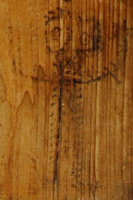
 |
|
 |
| Home |
| Background |
| Curriculum |
| The Schoolhouse |
| Teachers & Students |
| Apprenticeships |
| Artifacts |
| The Gymnasium |
| UM Papyrology Home |
| References |
| Credits |
This papyrus preserves definitions 1-10 of Euclid's Elements, a treatise on the nature of geometric features. Here, we reproduce the first seven definitions. Written in a small, rather personal hand on a narrow
piece of papyrus, it probably represents notes written for himself by
a schoolmaster, or perhaps a cheat sheet prepared by a student. This
sort of geometry would have been very important to engineers who were
responsible for constructing the canals that fed water to agricultural
zones, as well as to architects designing public buildings and palaces.
|
||
|
Click image for a larger version. Click here for full record. |
(1) σημεῖόν
ἐστιν οὗ μόρ<ι>ον |
(1) A point is that which has no part.
|